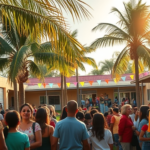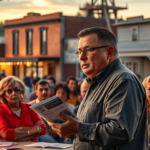Greater Economic Prosperity in Sight: RFI Event Empowers South Texas
Amidst rising interest in regional economic development, the “Request for Information Best Practices” event in Harlingen, Texas, on August 5, 2025, shone a spotlight on South Texas’s potential for attracting significant financial investment. Organized by the Council for South Texas Economic Progress (COSTEP), the event was designed to demystify the RFI process, equipping regional leaders with the tools to enhance their communities’ competitiveness within the state’s economic development pipeline.
Understanding the RFI’s Pivotal Role
The gathering underscored the indispensable role that Requests for Information (RFIs) play in economic development. This vital process effectively bridges community resources with inbound business opportunities, providing a structured way to attract attention from potential investors. Adam Gonzalez, CEO of COSTEP, emphasized the necessity for increased community involvement, saying, “The more we submit, the more chances we give South Texas to be on the map for major investments. It’s about creating opportunities.”
Sean Ferguson from the Texas Governor’s Office further elaborated on the significance of accurate and timely RFIs. He highlighted that these submissions are essential for building a robust economic brand for any community within the state. “Think of an RFI as your community’s résumé. It needs to be thorough, precise, and timely,” he noted, underscoring the importance for local Economic Development Organizations (EDOs) to act diligently.
Impact on the Rio Grande Valley
For the Rio Grande Valley (RGV), an area poised for growth but faced with economic disparities, optimizing the RFI process could be transformative. Hidalgo, Cameron, Starr, and Willacy counties, in particular, stand to benefit from increased investor interest triggered by more strategic RFI submissions. Valley residents could see an uptick in job opportunities and economic diversification, reinforcing the region’s potential as a vibrant business hub.
Local real estate consultant Michael Camden explained, “For the RGV, fine-tuning our approach in responding to RFIs can mean the difference between dwindling prospects and a thriving economy. The region has unique strengths, and getting them recognized requires precise communication with prospective investors.”
This sentiment resonates with Monica Sanchez, a San Juan native and local business owner. “A sharpened focus on showing off what the RGV offers can bring positive ripple effects. More businesses mean a robust community that supports local interests and generates a cycle of prosperity,” she expressed with optimism.
Challenges and Regional Collaboration
Despite these opportunities, the path to economic vitality has its challenges. Persistent underrepresentation in the development pipeline points to a need for coordinated regional strategies. Multiple speakers at the event, including Rick Carrera from COSTEP, stressed the importance of collaboration and capacity-building among local leaders.
Carrera elaborated on the collective task ahead: “While our region stretches from up near San Antonio down to El Paso, our collaboration hasn’t always mirrored our reach. We must open more dialogues across county lines and share best practices.”
Pioneers like Cameron County Judge Sandra Garcia see this as a call to action. “If we look beyond local barriers and think of South Texas as an interconnected economy, we can achieve substantial breakthroughs,” she said. Such collaboration could move the region beyond current hurdles and lead to prosperous outcomes for the entire South Texas area.
Past Implementations and Future Outlook
Building on past community engagement initiatives, the RFI Best Practices event marks yet another effort in a series of steps taken to enhance South Texas’s economic standing. Previously, local initiatives such as the Valley Development Coalition have successfully pooled resources to tackle communal economic challenges.
This time, however, the comprehensive focus on refining RFI submissions could strategically pivot the Valley’s economic pursuits toward more fruitful ventures, attracting interests from industries ranging from manufacturing to technology.
Looking ahead, the success of this initiative could act as a blueprint for other economically similar areas across the state. Encouragingly, Texas Border Business, a key player in promoting commerce across the Valley, remains active in covering such developments through platforms like MeGustaTV and a widespread publication reach—focusing on news that impacts Valley residents directly.
With robust distribution and community engagement, Texas Border Business ensures these conversations and learnings reach as wide an audience as possible. For residents interested in engaging further with economic discussions or accessing resources related to RFIs, regional contact points and platforms such as tbbmega.com provide valuable information.
In essence, the Harlingen event served as more than a gathering of leaders; it was a call to arms—a strategic push towards building a more prosperous and economically dynamic South Texas. As regional leaders increasingly embrace this collaborative spirit, the RGV’s economic future could indeed be as bright as its ambitions.







